
A few more Android games I've enjoyed: hocus, Idle Tribe, subpar pool
I’ve enjoyed 3 Android games lately, all in different genres and only one of them an incremental game! Here’s detailed reviews of them.
#1: hocus.
A minimalist brain-melting optical illusion-based cube-rolling puzzle game!
Screenshots
All screenshots are from version 7.0.1:
| Grid puzzle | Triangular puzzle | Level creator |
|---|---|---|
 |
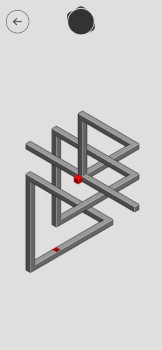 |
 |
Review
If you were playing free online flash games in the early 2000s, you might immediately think that “hocus” looks like “Bloxors”, an infuriatingly hard game. Luckily, it’s only similar on the surface, the gameplay is very different!
In hocus, you roll a small red cube around the level trying to get into the highlighted hole. You can’t go “around” the outside of corners, but can navigate on any surface you’re touching. The twist is… every level is an optical illusion, very similar to the “Impossible Triangle” (Penrose Triangle).
The truly baffling layout of each level means getting to the end is a genuine struggle. You’ll work your way around a complex structure, make your way to the exit… and then realise you’re on the wrong surface. Oops. Time to carry on your rolling journey and try another approach.
I’m not ashamed to admit my puzzle solving process was about 50% luck and 50% puzzle solving. I’d try to mentally work out which surfaces could get me to the exit, then how to get to those surfaces, and then wander around the level until one of them looked achievable. Or just swipe at random until I ended up somewhere interesting!
The game features 120 levels, and completing them can take either a few seconds or a few minutes each. Some of them will just “click” immediately, and others you’ll go slightly insane rolling in circles seemingly endlessly. These won’t take too long, and full completion took me perhaps 2-3 hours split across 2 sessions whilst watching videos.
Seems short? Well, yes, however there’s also an infinite (randomly generated) mode, and an astonishingly simple yet powerful level creator! I didn’t spend too much time with this, but the game’s approach of technically simple layouts resulting in complicated levels means recreating any of the game’s levels is very easy.
On that topic, I discovered hocus is also on Steam, making it a good place for finding custom levels. There are also a few on r/hocus. Despite being originally released in 2016, and having 10m+ installs, I couldn’t find any other decent sources of custom levels.
Overall, hocus will be a short but sweet puzzling experience that’ll frustrate you, then reward you with a healthy dose of dopamine, 120 times. Great!
Monetisation
I accessed hocus for free via Google Play Pass, but it looks like a one-off £1.99 payment unlocks the full game.
Tips
- I found it help to think in terms of flat surfaces, not tiles, when trying to figure out a successful route.
- Swiping randomly does work if you get stuck!
- Triangles are great for getting onto another side of a cube.
- The game doesn’t mislead you as much as I expected. If there’s an optional triangle on your way to the exit, you’ll probably need it!
- The circle at the top of the screen shows the available movement directions, early on the game this can help you understand normal movement methods.
- Due to the game’s confusing perspective, never assume how 2 poles are going to interact! I often found I’d unexpectedly be able to hop from one to the other, or be blocked, so it’s always worth trying out all possible routes.
#2: Idle Tribe
Idle Tribe isn’t doing anything new. But, it’s scratching the “build up a town without thinking much” incremental itch perfectly, without being too obnoxious about the monetisation!
Screenshots
All screenshots are from version 1.31.0:
| Island area | Dungeon area | Mine event | Avatars |
|---|---|---|---|
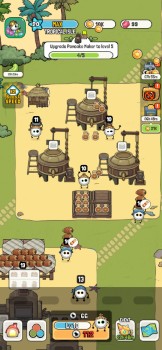 |
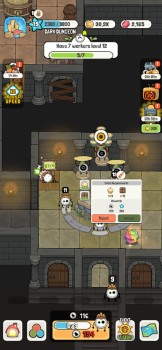 |
 |
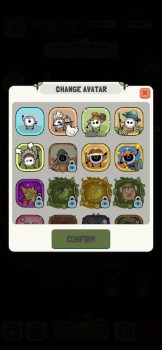 |
Review
In Idle Tribe, you’ll spend your time fulfilling orders from… sentient circles? The story is non-existent, but is also irrelevant. They pop up, ask for items, you provide them, receiving XP + gold / spawn coins in return. These materials are used for:
- XP: Level up, unlock new areas & increase worker level cap.
- Gold: Area upgrades, unlocking new areas.
- Spawn coins: Create workers, merging them to increase level.
The items requested start off simple, e.g. an apple from an apple tree farm you have, but quickly evolve as you unlock new areas. The new areas form supply chains with each other, with the ~20 different food items (not all in the same area) all flowing together in different zones (although not all at the same time).
Your workers are responsible for both producing and transporting your produced items, meaning there is a small amount of strategy involved in upgrading the most effective area. For example, it doesn’t make sense to upgrade your chocolate manufacturing plant if your cocoa powder area is always fully out of stock. Similarly, if you constantly have a bottleneck in a certain area, spending your spawn coins on upgrading those workers is probably a good idea.
This relatively simple formula of fulfilling orders and obtaining gold & spawn coins to upgrade areas & workers is not too appealing by itself. However, the game handles both prestiging and seasonal events well, making them all feel like progress towards an overall goal.
When an area is fully completed (usually when all areas & workers are maximum level), it provides passive income for the rest of your time with the game, at a fairly generous rate. There appear to be 13 areas in all (I’m finishing up area 12), although you can “prestige” an area which I haven’t tried yet. Every time I open the game there are a few thousand coins available, although my earlier grinding has meant money is no longer an issue.
Luckily, prestiging by moving to a new area does not mean you lose all your progress. You collect “cards” throughout, with upgrading each item (e.g. walk speed, or cocoa powder) being permanent and global. These benefits stack noticeably, with a highly upgraded produce item earning significantly more per item.
Similarly, whilst there are always 1-2 standalone events running for a few days, they provide benefits in the main game. This can be as simple as gems (the premium currency, you get given plenty!) for good performance, new avatars, or cards to upgrade items. These minigames vary from the very overused “mine & transport & sell” structure, to a copy of the main game set in the desert, to a beanstalk with each rung earning you rewards, and more. Whilst none of these games are complex or brand new, they provide a nice distraction from the core upgrading gameplay.
I suspect these events aren’t entirely real players, as you’ll soon notice your “competitors” seem to be slowly accumulating points at a steady rate throughout the event’s duration. A real player will gain them in short bursts as they actually play! My theory is the events are populated with fake scores based on real player highscores from previous occurrences of the event, slowly increasing until the end of event. Regardless, they’re still some form of multiplayer, real or not.
However, that’s if you find time to play them! Unlike many incremental games, you will never run out of “energy” in Idle Tribe. You may briefly not have enough coins or spawn coins, but these are rewarded with every order so you are constantly incentivised to keep playing. Many games would use this addictive “one more upgrade” trait in a more predatory way, but Idle Tribe seems content to just keep you playing, regardless of if you’re spending or not.
Overall, this is a time-consuming game that is excellent to mindlessly grind away at whilst on a call or waiting for something. You won’t have any amazing experiences or revelations, but you will get a steady stream of dopamine!
Monetisation
This is a game where spending money is rarely worth it. I purchased a very cheap starter pack early on, only to scale up so quickly that it became clear these paid items were almost worthless an hour later! There are all the usual limited time offers, season passes etc, but resources are given out so freely that they’ll rarely be attractive.
Similarly, there are gems but… you are given thousands of them for free. Nothing is locked behind them, and they are instead just a way to purchase extra chests (containing upgrade cards).
The only monetisation that is appealing is the incentivised adverts providing upgrade cards (none are forced). In seasonal events, watching an advert or two may reward upgrade cards relevant to your current upgrade task, which would otherwise be a complete blocker. During the desert event I probably “watched” (phone ignored on my desk, or advert muted) ~10 over the multi-day event and came first overall, highlighting how completely unnecessary any payment is.
Tips
- As mentioned, always upgrade your critical path. If an item isn’t fully stocked, it needs upgrading.
- Follow the tasks. Whilst you can upgrade anything in any order, generally you might as well follow the suggested upgrade to earn the extra gems.
- Participate in the events. They’re easy gems, and offer avatars!
- Offline rewards for events often aren’t calculated accurately until you re-enter an area. When reopening the app, briefly going into the main game and back will correctly reward the entire amount.
- Many events have leaderboards based on tasks completed, whereby the first person to complete all tasks is guaranteed first. As such, rushing to full completion is worth the early effort.
#3: subpar pool
I don’t particularly enjoy pool, mostly because I’m not very good! However, subpar pool has really hooked me recently, with the modifiers and challenges making each run feel unique, and challenging yet possible.
Screenshots
All screenshots are from version 1.0.4:
| Level select | Modifier select | Gameplay | Round win |
|---|---|---|---|
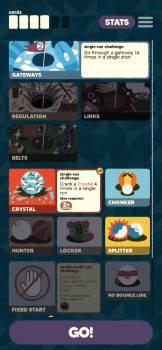 |
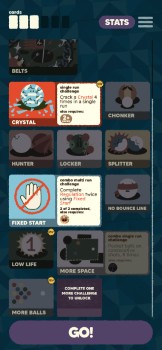 |
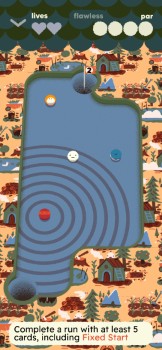 |
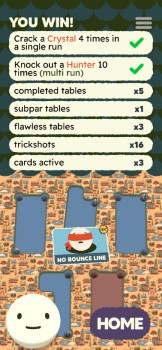 |
Review
In subpar pool, you’ll be playing relatively short 5-table rounds of pool across various maps and modifiers. Why? Well, to complete challenges to unlock more maps and modifiers!
Completing challenges unlocks more challenges, and these can be as simple as completing a specified table or as tricky as completing a certain number of ball pots after dying in a round. Most of these challenges can be completed first or second time if you’re a decent enough shot, but the real difficulty comes in:
- Trying to combine challenges for efficiency without making a round impossible.
- The occasional truly difficult challenges like potting 8 consecutive shots on a map with conveyor belts and extra awkward spaces added.
Gameplay itself is very simple, and essentially the same as pool: At the start of each table (or if you pot the white ball), drag where on the table you want to start. Then, line up your shots (there’s a “bounce line”) and get the balls in the holes. Easy!
Unlike real pool, the tables have impossible traits (teleports, moving holes, rotating conveyor belts), the balls are impossible (hunter balls chasing your white ball, balls that split, crystal balls that shatter), and there are plenty of extra traits available (fixed start position, extra balls to pot, fewer lives, etc).
This simple loop of selecting modifier cards with challenges to unlock new cards and challenges is very satisfying, with a sense of progress after ever 3-4 minute run. New content is also regularly unlocked, and the stats page reports I’ve played 46 runs and completed 42/196 challenges, with nearly 3 hours of gameplay.
Whilst I’m pretty confident I’ll get most of the way through subpar pool, I suspect there’ll be some challenges later on that I’m just not good enough for! For example, one challenge requires passing through a teleport on the “gateways” map 16 times in 1 short, and I’m yet to see a map layout that allows it. Perhaps there’ll be a modifier combination later on that allows it…
There’s no penalty for failing or abandoning the short runs, so trying experimental modifier combinations to complete as many challenges as possible is encouraged.
Monetisation
I accessed subpar pool as part of Google Play Pass, otherwise it’s a one-off £4.39 (~$5.99) purchase. There are no in-app purchases.
Tips
- With quick restarts, if you don’t make any progress towards a challenge on your first map, you might as well just restart the round.
- Pay attention to the “also requires” part of a challenge, if the challenge isn’t lit up then you don’t currently have all the required maps or modifiers selected.
- The holes are quite forgiving, so knocking a ball vaguely nearby a corner should get it in.
- There’s no penalty for potting the cue ball (excluding any challenge requirements), and it’s usually a good idea since you can freely place the white ball afterwards.